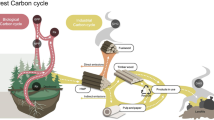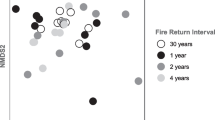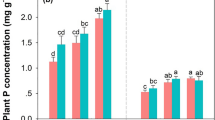Abstract
Aims
In subalpine grasslands, litter decomposition controls soil nutrient availability and is highly sensitive to increasing intensity and frequency of extreme climate events, potentially impacting grasslands diversity and functioning. Here, we assessed the effects of early snowmelt and summer drought on decomposition, and how these were modulated by agricultural management.
Methods
In a common garden, conservative and exploitative assembled communities were submitted for two years to combined snow removal and drought, and to cutting and fertilization. We measured decomposition rates of standard and native leaf material from each plant communities on their respective soils.
Results
We observed relatively weak climatic stress effects on decomposition rates. Management increased decomposition rates and remaining litter N contents through leaf quality improvement rather than changed soil biotic activity. Climate events impacted the decomposer community and limited litter N immobilization in conservative communities. Less recalcitrant litter of exploitative species facilitated decomposition and counterbalanced the negative effects of climate stress.
Conclusion
Our results suggest that drought and earlier snowmelt could decrease N availability in subalpine grasslands due to reduced litter biomass and decomposition. In the long-term climate change may shift subalpine grasslands towards more conservative plant composition and lower soil fertility.




Similar content being viewed by others
References
Aerts R (1997) Climate, leaf litter chemistry and leaf litter decomposition in terrestrial ecosystems: a triangular relationship. Oikos 79:439–449. https://doi.org/10.2307/3546886
Aerts R (1999) Interspecific competition in natural plant communities: mechanisms, trade-offs and plant-soil feedbacks. J Exp Bot 50:29–37. https://doi.org/10.1093/jxb/50.330.29
Aerts R (2006) The freezer defrosting: global warming and litter decomposition rates in cold biomes. J Ecol 94:713–724. https://doi.org/10.1111/j.1365-2745.2006.01142.x
Allen RG, Pereira LS, Raes D, Smith M (1998) Crop evapotranspiration: guidelines for computing crop water requirements - irrigation and drainage paper 56. Food and agricultural Organization of the United Nations, Rome, Italy
Allison SD, Martiny JBH (2008) Resistance, resilience, and redundancy in microbial communities. Proc Natl Acad Sci 105:11512–11519. https://doi.org/10.1073/pnas.0801925105
Austin AT, Vivanco L (2006) Plant litter decomposition in a semi-arid ecosystem controlled by photodegradation. Nature 442:555–558
Bahn M, Reichstein M, Dukes JS, Smith MD, McDowell NG (2014) Climate–biosphere interactions in a more extreme world. New Phytol 202:356–359. https://doi.org/10.1111/nph.12662
Baptist F, Choler P (2008) A simulation of the importance of length of growing season and canopy functional properties on the seasonal gross primary production of temperate alpine meadows. Ann Bot 101:549–559. https://doi.org/10.1093/aob/mcm318
Baptist F, Zinger L, Clement JC, Gallet C, Guillemin R, Martins JMF, Sage L, Shahnavaz B, Choler P, Geremia R (2008) Tannin impacts on microbial diversity and the functioning of alpine soils: a multidisciplinary approach. Environ Microbiol 10:799–809. https://doi.org/10.1111/j.1462-2920.2007.01504.x
Baptist F, Yoccoz NG, Choler P (2010) Direct and indirect control by snow cover over decomposition in alpine tundra along a snowmelt gradient. Plant Soil 328:397–410. https://doi.org/10.1007/s11104-009-0119-6
Bardgett RD, Bowman WD, Kaufmann R, Schmidt SK (2005) A temporal approach to linking aboveground and belowground ecology. Trends Ecol Evol 20:634–641. https://doi.org/10.1016/j.tree.2005.08.005
Bernard L (2017) Mécanismes fonctionnels de résilience des prairies subalpines au changement global. PhD thesis, Université Grenoble Alpes
Binet MN, Sage L, Malan C, Clément JC, Redecker D, Wipf D, Geremia RA, Lavorel S, Mouhamadou B (2013) Effects of mowing on fungal endophytes and arbuscular mycorrhizal fungi in subalpine grasslands. Fungal Ecol 6:248–255. https://doi.org/10.1016/j.funeco.2013.04.001
Binet M-N, van Tuinen D, Souard F, Sage L, Périgon S, Gallet C, Legay N, Lavorel S, Mouhamadou B (2017) Responses of above- and below-ground fungal symbionts to cessation of mowing in subalpine grassland. Fungal Ecol 25:14–21. https://doi.org/10.1016/j.funeco.2016.10.001
Bloor JMG, Bardgett RD (2012) Stability of above-ground and below-ground processes to extreme drought in model grassland ecosystems: interactions with plant species diversity and soil nitrogen availability. Perspect Plant Ecol Evol Syst 14:193–204. https://doi.org/10.1016/j.ppees.2011.12.001
Bokhorst S, Bjerke JW, Melillo J, Callaghan TV, Phoenix GK (2010) Impacts of extreme winter warming events on litter decomposition in a sub-Arctic heathland. Soil Biol Biochem 42:611–617. https://doi.org/10.1016/j.soilbio.2009.12.011
Bokhorst S, Phoenix GK, Bjerke JW, Callaghan TV, Huyer-Brugman F, Berg MP (2012) Extreme winter warming events more negatively impact small rather than large soil fauna: shift in community composition explained by traits not taxa. Glob Chang Biol 18:1152–1162. https://doi.org/10.1111/j.1365-2486.2011.02565.x
Cornelissen JHC (1996) An experimental comparison of leaf decomposition rates in a wide range of temperate plant species and types. J Ecol 84:573–582
Cornelissen JHC, Van Bodegom PM, Aerts R et al (2007) Global negative vegetation feedback to climate warming responses of leaf litter decomposition rates in cold biomes. Ecol Lett 10:619–627. https://doi.org/10.1111/j.1461-0248.2007.01051.x
Cornwell WK, Cornelissen JHC, Amatangelo K, Dorrepaal E, Eviner VT, Godoy O, Hobbie SE, Hoorens B, Kurokawa H, Pérez-Harguindeguy N, Quested HM, Santiago LS, Wardle DA, Wright IJ, Aerts R, Allison SD, van Bodegom P, Brovkin V, Chatain A, Callaghan TV, Díaz S, Garnier E, Gurvich DE, Kazakou E, Klein JA, Read J, Reich PB, Soudzilovskaia NA, Vaieretti MV, Westoby M (2008) Plant species traits are the predominant control on litter decomposition rates within biomes worldwide. Ecol Lett 11:1065–1071. https://doi.org/10.1111/j.1461-0248.2008.01219.x
Coûteaux M-M, Bottner P, Berg B (1995) Litter decomposition, climate and liter quality. Trends Ecol Evol 10:63–66. https://doi.org/10.1016/S0169-5347(00)88978-8
Crawley MJ (2005) Statistics: an introduction using R. John Wiley & Sons Ltd, Chichester
De Deyn GB, Cornelissen JHC, Bardgett RD (2008) Plant functional traits and soil carbon sequestration in contrasting biomes. Ecol Lett 11:516–531. https://doi.org/10.1111/j.1461-0248.2008.01164.x
De Deyn GB, Quirk H, Bardgett RD (2010) Plant species richness, identity and productivity differentially influence key groups of microbes in grassland soils of contrasting fertility. Biol Lett
de Vries FT, Shade A (2013) Controls on soil microbial community stability under climate change. Front Microbiol 4:1–16. https://doi.org/10.3389/fmicb.2013.00265
de Vries FT, Liiri ME, Bjørnlund L, Setälä HM, Christensen S, Bardgett RD (2012a) Legacy effects of drought on plant growth and the soil food web. Oecologia 170:821–833. https://doi.org/10.1007/s00442-012-2331-y
de Vries FT, Manning P, Tallowin JRB, Mortimer SR, Pilgrim ES, Harrison KA, Hobbs PJ, Quirk H, Shipley B, Cornelissen JHC, Kattge J, Bardgett RD (2012b) Abiotic drivers and plant traits explain landscape-scale patterns in soil microbial communities. Ecol Lett 15:1230–1239. https://doi.org/10.1111/j.1461-0248.2012.01844.x
Dirnböck T, Dullinger S, Grabherr G (2003) A regional impact assessment of climate and land-use change on alpine vegetation. J Biogeogr 30:401–417. https://doi.org/10.1046/j.1365-2699.2003.00839.x
Durand Y, Laternser M, Giraud G, Etchevers P, Lesaffre B, Mérindol L (2009) Reanalysis of 44 Yr of climate in the French Alps (1958–2002): methodology, model validation, climatology, and trends for air temperature and precipitation. J Appl Meteorol Climatol 48:429–449. https://doi.org/10.1175/2008JAMC1808.1
Edwards AC, Scalenghe R, Freppaz M (2007) Changes in the seasonal snow cover of alpine regions and its effect on soil processes: a review. Quat Int 162–163:172–181. https://doi.org/10.1016/j.quaint.2006.10.027
Ehrenfeld JG, Ravit B, Elgersma K (2005) Feedback in the plant-soil system. Annu Rev Environ Resour 30:75–115. https://doi.org/10.1146/annurev.energy.30.050504.144212
Engler R, Randin CF, Thuiller W et al (2011) 21st century climate change threatens mountain flora unequally across Europe. Glob Chang Biol 17:2330–2341. https://doi.org/10.1111/j.1365-2486.2010.02393.x
Feng X, Nielsen LL, Simpson MJ (2007) Responses of soil organic matter and microorganisms to freeze–thaw cycles. Soil Biol Biochem 39:2027–2037. https://doi.org/10.1016/j.soilbio.2007.03.003
Garnier E, Cortez J, Billès G, Navas ML, Roumet C, Debussche M, Laurent G, Blanchard A, Aubry D, Bellmann A, Neill C, Toussaint JP (2004) Plant functional markers capture ecosystem properties during secondary succession. Ecology 85:2630–2637. https://doi.org/10.1890/03-0799
Gartner TB, Cardon ZG (2004) Decomposition dynamics in mixed-species leaf litter. Oikos 104:230–246. https://doi.org/10.1111/j.0030-1299.2004.12738.x
Gessner MO, Swan CM, Dang CK, McKie BG, Bardgett RD, Wall DH, Hättenschwiler S (2010) Diversity meets decomposition. Trends Ecol Evol 25:372–380. https://doi.org/10.1016/j.tree.2010.01.010
Gobiet A, Kotlarski S, Beniston M, Heinrich G, Rajczak J, Stoffel M (2014) 21st century climate change in the European Alps—a review. Sci Total Environ 493:1138–1151. https://doi.org/10.1016/j.scitotenv.2013.07.050
Grêt-Regamey A, Brunner SH, Kienast F (2012) Mountain ecosystem services: who cares? Mt Res Dev 32:S23–S34. https://doi.org/10.1659/MRD-JOURNAL-D-10-00115.S1
Grigulis K, Lavorel S, Krainer U, Legay N, Baxendale C, Dumont M, Kastl E, Arnoldi C, Bardgett RD, Poly F, Pommier T, Schloter M, Tappeiner U, Bahn M, Clément JC (2013) Relative contributions of plant traits and soil microbial properties to mountain grassland ecosystem services. J Ecol 101:47–57. https://doi.org/10.1111/1365-2745.12014
Gross N, Suding KNK, Lavorel S (2007) Leaf dry matter content and lateral spread predict response to land use change for six subalpine grassland species. J Veg Sci 18:289–300. https://doi.org/10.1111/j.1654-1103.2007.tb02540.x
Haida C, Rüdisser J, Tappeiner U (2016) Ecosystem services in mountain regions: experts’ perceptions and research intensity. Reg Environ Chang 16:1989–2004. https://doi.org/10.1007/s10113-015-0759-4
Hättenschwiler S, Tiunov AV, Scheu S (2005) Biodiversity and litter decomposition in terrestrial ecosystems. Annu Rev Ecol Evol Syst 36:191–218
Hefting MM, Clement J-C, Bienkowski P, Dowrick D, Guenat C, Butturini A, Topa S, Pinay G, Verhoeven JTA (2005) The role of vegetation and litter in the nitrogen dynamics of riparian buffer zones in Europe. Ecol Eng 24:465–482. https://doi.org/10.1016/j.ecoleng.2005.01.003
Hobbie SE (1992) Effects of plant species on nutrient cycling. Trends Ecol Evol 7:336–339. https://doi.org/10.1016/0169-5347(92)90126-V
Hobbie SE (1996) Temperature and plant species control over litter decomposition in Alaskan tundra. Ecol Monogr 66:503–522. https://doi.org/10.2307/2963492
Hobbie SE (2008) Nitrogen effects on decomposition: a five-year experiment in eight temperate sites. Ecology 89:2633–2644. https://doi.org/10.1890/07-1119.1
Ibanez S, Bernard L, Coq S, Moretti M, Lavorel S, Gallet C (2013) Herbivory differentially alters litter dynamics of two functionally contrasted grasses. Funct Ecol 27:1064–1074. https://doi.org/10.1111/1365-2435.12094
Jefferies RL, Walker NA, Edwards K a, Dainty J (2010) Is the decline of soil microbial biomass in late winter coupled to changes in the physical state of cold soils? Soil Biol Biochem 42:129–135. https://doi.org/10.1016/j.soilbio.2009.10.008
Jung V, Albert CH, Violle C, Kunstler G, Loucougaray G, Spiegelberger T (2014) Intraspecific trait variability mediates the response of subalpine grassland communities to extreme drought events. J Ecol 102:45–53. https://doi.org/10.1111/1365-2745.12177
Kazakou E, Vile D, Shipley B et al (2006) Co-variations in litter decomposition, leaf traits and plant growth in species from a Mediterranean old-field succession. Funct Ecol 20:21–30. https://doi.org/10.1111/j.1365-2435.2006.01080.x
Kreyling J, Beierkuhnlein C, Jentsch A (2010) Effects of soil freeze–thaw cycles differ between experimental plant communities. J Basic Appl Ecol 11:65–75. https://doi.org/10.1016/j.baae.2009.07.008
Lavorel S, Grigulis K, Leitinger G, Kohler M, Schirpke U, Tappeiner U (2017) Historical trajectories in land use pattern and grassland ecosystem services in two European alpine landscapes. Reg Environ Chang 17:2251–2264. https://doi.org/10.1007/s10113-017-1207-4
Legay N, Grassein F, Robson TM, Personeni E, Bataillé M-P, Lavorel S, Clément J-C (2013) Comparison of inorganic nitrogen uptake dynamics following snowmelt and at peak biomass in subalpine grasslands. Biogeosciences 10(11):7631–7645
Lenth RV (2016) Least-squares means: the R package lsmeans. J Stat Softw 69(1):133. https://doi.org/10.18637/jss.v069.i
Manning P, Saunders M, Bardgett RD, Bonkowski M, Bradford MA, Ellis RJ, Kandeler E, Marhan S, Tscherko D (2008) Direct and indirect effects of nitrogen deposition on litter decomposition. Soil Biol Biochem 40:688–698. https://doi.org/10.1016/j.soilbio.2007.08.023
Melillo JM, Aber JD, Muratore JF (1982) Nitrogen and lignin control of hardwood leaf litter decomposition dynamics. Ecology 63:621–626. https://doi.org/10.2307/1936780
Morin S, Lafaysse M, Coleou C, Lejeune Y (2013) Will there (still) be snow for the upcoming winter holidays? On the conditional predictability of snow conditions several weeks to months in advance. In: International snow science workshop. Grenoble - Chamonix Mont-Blanc, France, pp 1171–1176
Niedrist G, Tasser E, Lüth C, Dalla Via J, Tappeiner U (2008) Plant diversity declines with recent land use changes in European Alps. Plant Ecol 202:195–210. https://doi.org/10.1007/s11258-008-9487-x
Orwin KH, Buckland SM, Johnson D, Turner BL, Smart S, Oakley S, Bardgett RD (2010) Linkages of plant traits to soil properties and the functioning of temperate grassland. J Ecol 98:1074–1083. https://doi.org/10.1111/j.1365-2745.2010.01679.x
Parton W, Silver WL, Burke IC, Grassens L, Harmon ME, Currie WS, King JY, Adair EC, Brandt LA, Hart SC, Fasth B (2007) Global-scale similarities in nitrogen release patterns during long-term decomposition. Science (80- ) 315:361–364. https://doi.org/10.1126/science.1134853
Pinheiro J, Bates D, DebRoy S, Sarkar D, R Core Team (2017) nlme: linear and nonlinear mixed effects models. R package version 3.1–131
Quétier F, Thébault A, Lavorel S (2007) Plant traits in a state and transition framework as markers of ecosystem response to land-use change. Ecol Monogr 77:33–52. https://doi.org/10.1890/06-0054
R Core Team (2017) R: A language and environment for statistical computing. R Foundation for Statistical Computing, Vienna, Austria
Robson T, Lavorel S, Clement J, Roux X (2007) Neglect of mowing and manuring leads to slower nitrogen cycling in subalpine grasslands. Soil Biol Biochem 39:930–941. https://doi.org/10.1016/j.soilbio.2006.11.004
Robson TM, Baptist F, Clément J-C, Lavorel S (2010) Land use in subalpine grasslands affects nitrogen cycling via changes in plant community and soil microbial uptake dynamics. J Ecol 98:62–73. https://doi.org/10.1111/j.1365-2745.2009.01609.x
Saccone P, Morin S, Baptist F, Bonneville JM, Colace MP, Domine F, Faure M, Geremia R, Lochet J, Poly F, Lavorel S, Clément JC (2013) The effects of snowpack properties and plant strategies on litter decomposition during winter in subalpine meadows. Plant Soil 363:215–229. https://doi.org/10.1007/s11104-012-1307-3
Sanaullah M, Rumpel C, Charrier X, Chabbi A (2012) How does drought stress influence the decomposition of plant litter with contrasting quality in a grassland ecosystem? Plant Soil 352:277–288. https://doi.org/10.1007/s11104-011-0995-4
Sayer EJ, Oliver AE, Fridley JD, Askew AP, Mills RTE, Grime JP (2017) Links between soil microbial communities and plant traits in a species-rich grassland under long-term climate change. Ecol Evol 7:855–862. https://doi.org/10.1002/ece3.2700
Schimel JP, Bennett J (2004) Nitrogen mineralization: challenges of a changing paradigm. Ecology 85:591–602. https://doi.org/10.1890/03-8002
Schimel JP, Hättenschwiler S (2007) Nitrogen transfer between decomposing leaves of different N status. Soil Biol Biochem 39:1428–1436. https://doi.org/10.1016/j.soilbio.2006.12.037
Schimel J, Balser T, Wallenstein M (2007) Microbial stress-response physiology and its implications for ecosystem function. Ecology 88:1386–1394
Schuster MJ (2016) Increased rainfall variability and N addition accelerate litter decomposition in a restored prairie. Oecologia 180:645–655. https://doi.org/10.1007/s00442-015-3396-1
Strickland MS, Lauber C, Fierer N, Bradford MA (2009) Testing the functional significance of microbial community composition. Ecology 90:441–451. https://doi.org/10.1890/08-0296.1
Swift MJ, Heal OW, Anderson JM (1979) Decomposition in terrestrial ecosystems. University of California Press, Berkeley
Taylor BR, Parkinson D, Parsons WFJ (1989) Nitrogen and lignin content as predictors of litter decay rates: a microcosm test. Ecology 70:97–104. https://doi.org/10.2307/1938416
Tu L, Hu H, Chen G, Peng Y, Xiao YL, Hu TX, Zhang J, Li XW, Liu L, Tang Y (2014) Nitrogen addition significantly affects Forest litter decomposition under high levels of ambient nitrogen deposition. PLoS One 9:1–9. https://doi.org/10.1371/journal.pone.0088752
Vionnet V, Brun E, Morin S, Boone A, Faroux S, le Moigne P, Martin E, Willemet JM (2012) The detailed snowpack scheme Crocus and its implementation in SURFEX v7.2. Geosci Model Dev 5:773–791. https://doi.org/10.5194/gmd-5-773-2012
Vogel A, Eisenhauer N, Weigelt A, Scherer-Lorenzen M (2013) Plant diversity does not buffer drought effects on early-stage litter mass loss rates and microbial properties. Glob Chang Biol 19:2795–2803. https://doi.org/10.1111/gcb.12225
Volaire F (2018) A unified framework of plant adaptive strategies to drought: crossing scales and disciplines. Glob Chang Biol 0:2929–2938. https://doi.org/10.1111/gcb.14062
Walter J, Grant K, Beierkuhnlein C, Kreyling J, Weber M, Jentsch A (2012) Increased rainfall variability reduces biomass and forage quality of temperate grassland largely independent of mowing frequency. Agric Ecosyst Environ 148:1–10. https://doi.org/10.1016/j.agee.2011.11.015
Walter J, Hein R, Beierkuhnlein C, Hammerl V, Jentsch A, Schädler M, Schuerings J, Kreyling J (2013) Combined effects of multifactor climate change and land-use on decomposition in temperate grassland. Soil Biol Biochem 60:10–18. https://doi.org/10.1016/j.soilbio.2013.01.018
Wardle DA, Barker GM, Bonner KI, Nicholson KS (1998) Can comparative approaches based on plant ecophysiological traits predict the nature of biotic interactions and individual plant species effects in ecosystems? J Ecol 86:405–420. https://doi.org/10.1046/j.1365-2745.1998.00268.x
Wardle DA, Bardgett RD, Klironomos JN, Setälä H, van der Putten W, Wall DH (2004) Ecological linkages between aboveground and belowground biota. Science (80- ) 304:1629–1633. https://doi.org/10.1126/science.1094875
Wu F, Yang W, Zhang J, Deng R (2010) Litter decomposition in two subalpine forests during the freeze–thaw season. Acta Oecol 36:135–140. https://doi.org/10.1016/j.actao.2009.11.002
Zhang T (2005) Influence of the seasonal snow cover on the ground thermal regime: an overview. Rev Geophys 43:n/a--n/a. https://doi.org/10.1029/2004RG000157
Zhang D, Hui D, Luo Y, Zhou G (2008) Rates of litter decomposition in terrestrial ecosystems: global patterns and controlling factors. J Plant Ecol 1:85–93. https://doi.org/10.1093/jpe/rtn002
Zoderer BM, Lupo Stanghellini PS, Tasser E, Walde J, Wieser H, Tappeiner U (2016) Exploring socio-cultural values of ecosystem service categories in the Central Alps: the influence of socio-demographic factors and landscape type. Reg Environ Chang 16:2033–2044. https://doi.org/10.1007/s10113-015-0922-y
Acknowledgments
We are grateful to Adeline Bierry, Jean-Marc Bonneville, Coline Byczek, Amélie Cantarel, Emilie Crouzat, Franck Delbart, Caroline Devaux, Marine Gabillet, Rachel Gerardin, Ludovic Gielly, Pierre Gos, Karl Grigulis, Fanny Guillot, Nadine Guillaumaud, Nicolas Legay, Remy Lasseur, Maud Mouchet, Franck Poly, Thomas Pommier and Laure Zupan for their help with the global change experiment, Cindy Arnoldi and Jonathan Corjon for their help with chemical analyses. This study was supported by the ERA-Net BiodivERsA project REGARDS (ANR-12-EBID-004-01). Lionel Bernard was funded by the ECO-SERVE project during the writing up of this manuscript through the 2013–2014 BiodivERsA/FACCE-JPI joint call for research proposals, with the national funders ANR, NWO, FCT, MINECO, FORMAS, and SNSF. This research was conducted at ‘Jardin du Lautaret’(UMS 3370 Univ. Grenoble Alpes – CNRS), a member of AnaEE-France (ANR-11-INBS-0001AnaEE-Services), on the LTSER platform ‘Zone Atelier Alpes’, a member of the ILTER-Europe network.
Author information
Authors and Affiliations
Corresponding author
Ethics declarations
Conflict of interest
The authors declare that they have no conflict of interest.
Additional information
Responsible Editor: Amandine Erktan.
Electronic supplementary material
ESM 1
(DOCX 1199 kb)
Rights and permissions
About this article
Cite this article
Bernard, L., Foulquier, A., Gallet, C. et al. Effects of snow pack reduction and drought on litter decomposition in subalpine grassland communities. Plant Soil 435, 225–238 (2019). https://doi.org/10.1007/s11104-018-3891-3
Received:
Accepted:
Published:
Issue Date:
DOI: https://doi.org/10.1007/s11104-018-3891-3




